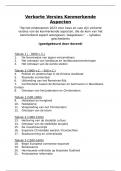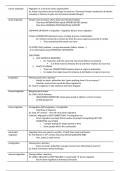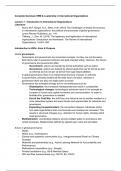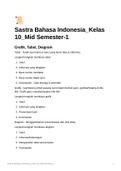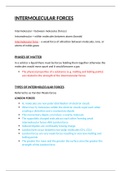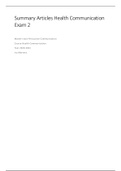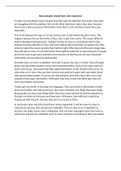GLOBAL HEALTH, PHARMACOTHERAPY AND COMMUNICATION
INTRODUCTION – global health and pharmacotherapy
Health is a state of complete physical, mental and social well-being and not merely
the absence of disease or infirmity (invaliditeit).
The World Health Organization (WHO) leads global efforts to expand universal health
coverage. So that everyone, everywhere have an equal chance to live a healthy life.
So it promotes healthier populations.
Global health is an area for study, research, and practice that places a priority on
improving health and achieving equity in health for all people worldwide. Climate
change is the greatest global health threat.
(1) Food insecurity is being exacerbated by the increasing frequency of heat
waves
(2) Vulnerable populations are facing increased exposure to extreme, life-
threatening heat.
(3) Climate suitability for the spread of infectious diseases such as malaria is
rising
What can we do? → green pharmacy: reducing the negative impact of the health
care sector and reducing drug pollution are a priority.
The health care sector contributes to 4.4% of the global net emissions. How to make
drugs more sustainable (duurzaam)? → change the way drugs are synthesized in the
industry –
- Reduce the number of steps in the process of synthesizing medicines
- Replace chemical substances in the synthesis of medicines with enzymes
An example of a global pandemic is COVID-19, which is a respiratory infection
caused by the coronavirus SARS-CoV-2. The symptoms can range from mild
common illness to severe viral pneumonia with potentially fatal acute respiratory
distress syndrome.
- Complications of severe disease: multi-organ failure, septic shock, blood clots
- Long-term complication: long COVID
How to determine the risk to die from a COVID-19 infection?
- Crude mortality rate: dividing the number of deaths from the disease by the total
population
- The case fatality rate (CFR) is the number of confirmed deaths divided by the
number of confirmed cases
- Infection fatality rate (IFR) is the number of deaths from a disease divided by the
total number of cases
1
,Different types of COVID-19 vaccines have been developed by the European
Medicines Agency (EMA), including mRNA vaccines, viral vector vaccines, and
protein subunit vaccines. These vaccines work by presenting a harmless part of the
virus to the immune system, which triggers an immune response.
However, there were inequities (ongelijkheden) in access to vaccines and tests. 0.4%
of tests globally have been carried out in low-income countries.
What are other threats to global health?
- Lack of stable health care systems
- Communicable diseases/infectious diseases
- Non-communicable diseases
There is at least 22% of the global population without access to basic care because
of drought, famine (hongersnood), conflict, and population displacement.
- Dysfunctional health systems (weak primary health care)
- Lack of childhood vaccination
- Malnutrition of children
Communicable diseases, also known as infectious diseases, are caused by
pathogenic microorganisms such as bacteria, viruses, parasites, or fungi. These
diseases can be transmitted from one person to another through various modes of
transmission, such as direct contact, respiratory droplets, contaminated food or
water, insect bites, or sexual contact.
Non-communicable diseases, on the other hand, are medical conditions that are not
infectious and cannot be transmitted from person to person. They are typically
caused by a combination of genetic, environmental, and lifestyle factors. They are
generally chronic and long-lasting.
Which infectious diseases/communicable diseases form a global health threat?
- Global influenza pandemic
- Dengue
- HIV/AIDS
- Ebola and other high-threat pathogens (the cases reduce due to licensed
Ebola vaccine)
- Antimicrobial resistance
Dengue is a viral infection caused by the dengue virus. It is transmitted through
mosquito (muggen), especially during rainy seasons of countries such as Bangladesh
and India. It causes flu-like symptoms.
- 390 million infections a year, about 40% of the world is at risk of dengue fever
- Up to 20% of those with severe dengue die
Which non-communicable diseases form a global health threat?
- Diabetes
- Cancer
- Heart disease
- Dementia (8.1% in women over 65 years & 5.4% in men over 65 years)
2
,Top 10 global causes of death in 2019:
- Ischaemic heart disease
- Stroke
- Chronic obstructive pulmonary disease/COPD
- Lower respiratory infections
- Neonatal conditions
- Trachea, bronchus, lung cancers
- Alzheimer disease and other dementias
- Diarrhoeal diseases
- Diabetes mellitus
- Kidney diseases
The Healthcare Access and Quality (HAQ) index
is measured on a scale from 0 (worst) to 100
(best). It is based on death rates from 32 causes
of death that could be avoided by timely and
effective medical care (amenable mortality).
Progress in global health – reducing the number of deaths caused by:
- Communicable diseases
- Maternal and perinatal deaths (deaths that occur during pregnancy, childbirth,
or within the first 28 days after birth)
- Malnutrition
Progress especially in children under 5 years of age.
SDG: sustainable development goals – end poverty, protect the planet and ensure
that all people enjoy peace and prosperity by 2030.
Targets for SDG 3 to be achieved by 2030:
- Global maternal mortality
- Preventable deaths of newborns and children (<5 years)
- AIDS, tuberculosis, malaria, neglected tropical diseases, hepatitis, water-
borne diseases and other communicable diseases.
- Premature mortality from non-communicable diseases and mental health
- Substance abuse (narcotics, alcohol etc)
- Road traffic accidents.
- Access to sexual and reproductive health-care services
- Universal health coverage
- Deaths/illnesses from hazardous chemicals and air, water and soil pollution
and contamination.
- Tobacco Control
- Research/development of vaccines and medicines for diseases of developing
countries and access to affordable essential medicines and vaccines
- Health financing and health workforce in developing countries
- Early warning, risk reduction and management of national and global health
risks
3
, Universal health coverage is a concept that aims to ensure that all individuals and
communities have access to essential health services without facing financial
hardship. So the following description is INCORRECT: universal health coverage
means that people do not have to pay for their drug treatment.
Between 2000 and 2019, major gains in health have occurred at global level, some
indicators show this such as:
- Increased life expectancy and healthy life expectancy at birth
- The fastest improvements in low income countries
- Remarkable progress in reducing child mortality and major communicable
diseases
However, the global outbreak of COVID-19 had a big impact on achieving a healthier
world.
Pharmacotherapy is the use of medicine for prevention of diseases and treatment of
diseases and symptoms.
What happens when you swallow a
medicine? → pharmacokinetics (how
the body affects the drug): ADME
- Absorption
- Distribution
- (Binding)
- Metabolism
- Excretion
Pharmacodynamics is how the drug
affects the body: biochemical, cellular, and physiological effects of drugs and their
mechanism of action. The effect of the drug is often due to their interaction with drug
receptors or drug targets.
An individual’s response to a drug depends on:
- Age
- Gender
- Pharmacogenetics
- Organ function (e.g. kidney/liver)
- Co-morbidities
- Co-medication
Drug interactions may occur when patients take:
- More than one prescribed drug
- Use over-the-counter medications, vitamins, and other ‘natural’ supplements in
addition to prescribed medicines
- Unusual diets
Consequence: failure of therapy or toxicity.
4
INTRODUCTION – global health and pharmacotherapy
Health is a state of complete physical, mental and social well-being and not merely
the absence of disease or infirmity (invaliditeit).
The World Health Organization (WHO) leads global efforts to expand universal health
coverage. So that everyone, everywhere have an equal chance to live a healthy life.
So it promotes healthier populations.
Global health is an area for study, research, and practice that places a priority on
improving health and achieving equity in health for all people worldwide. Climate
change is the greatest global health threat.
(1) Food insecurity is being exacerbated by the increasing frequency of heat
waves
(2) Vulnerable populations are facing increased exposure to extreme, life-
threatening heat.
(3) Climate suitability for the spread of infectious diseases such as malaria is
rising
What can we do? → green pharmacy: reducing the negative impact of the health
care sector and reducing drug pollution are a priority.
The health care sector contributes to 4.4% of the global net emissions. How to make
drugs more sustainable (duurzaam)? → change the way drugs are synthesized in the
industry –
- Reduce the number of steps in the process of synthesizing medicines
- Replace chemical substances in the synthesis of medicines with enzymes
An example of a global pandemic is COVID-19, which is a respiratory infection
caused by the coronavirus SARS-CoV-2. The symptoms can range from mild
common illness to severe viral pneumonia with potentially fatal acute respiratory
distress syndrome.
- Complications of severe disease: multi-organ failure, septic shock, blood clots
- Long-term complication: long COVID
How to determine the risk to die from a COVID-19 infection?
- Crude mortality rate: dividing the number of deaths from the disease by the total
population
- The case fatality rate (CFR) is the number of confirmed deaths divided by the
number of confirmed cases
- Infection fatality rate (IFR) is the number of deaths from a disease divided by the
total number of cases
1
,Different types of COVID-19 vaccines have been developed by the European
Medicines Agency (EMA), including mRNA vaccines, viral vector vaccines, and
protein subunit vaccines. These vaccines work by presenting a harmless part of the
virus to the immune system, which triggers an immune response.
However, there were inequities (ongelijkheden) in access to vaccines and tests. 0.4%
of tests globally have been carried out in low-income countries.
What are other threats to global health?
- Lack of stable health care systems
- Communicable diseases/infectious diseases
- Non-communicable diseases
There is at least 22% of the global population without access to basic care because
of drought, famine (hongersnood), conflict, and population displacement.
- Dysfunctional health systems (weak primary health care)
- Lack of childhood vaccination
- Malnutrition of children
Communicable diseases, also known as infectious diseases, are caused by
pathogenic microorganisms such as bacteria, viruses, parasites, or fungi. These
diseases can be transmitted from one person to another through various modes of
transmission, such as direct contact, respiratory droplets, contaminated food or
water, insect bites, or sexual contact.
Non-communicable diseases, on the other hand, are medical conditions that are not
infectious and cannot be transmitted from person to person. They are typically
caused by a combination of genetic, environmental, and lifestyle factors. They are
generally chronic and long-lasting.
Which infectious diseases/communicable diseases form a global health threat?
- Global influenza pandemic
- Dengue
- HIV/AIDS
- Ebola and other high-threat pathogens (the cases reduce due to licensed
Ebola vaccine)
- Antimicrobial resistance
Dengue is a viral infection caused by the dengue virus. It is transmitted through
mosquito (muggen), especially during rainy seasons of countries such as Bangladesh
and India. It causes flu-like symptoms.
- 390 million infections a year, about 40% of the world is at risk of dengue fever
- Up to 20% of those with severe dengue die
Which non-communicable diseases form a global health threat?
- Diabetes
- Cancer
- Heart disease
- Dementia (8.1% in women over 65 years & 5.4% in men over 65 years)
2
,Top 10 global causes of death in 2019:
- Ischaemic heart disease
- Stroke
- Chronic obstructive pulmonary disease/COPD
- Lower respiratory infections
- Neonatal conditions
- Trachea, bronchus, lung cancers
- Alzheimer disease and other dementias
- Diarrhoeal diseases
- Diabetes mellitus
- Kidney diseases
The Healthcare Access and Quality (HAQ) index
is measured on a scale from 0 (worst) to 100
(best). It is based on death rates from 32 causes
of death that could be avoided by timely and
effective medical care (amenable mortality).
Progress in global health – reducing the number of deaths caused by:
- Communicable diseases
- Maternal and perinatal deaths (deaths that occur during pregnancy, childbirth,
or within the first 28 days after birth)
- Malnutrition
Progress especially in children under 5 years of age.
SDG: sustainable development goals – end poverty, protect the planet and ensure
that all people enjoy peace and prosperity by 2030.
Targets for SDG 3 to be achieved by 2030:
- Global maternal mortality
- Preventable deaths of newborns and children (<5 years)
- AIDS, tuberculosis, malaria, neglected tropical diseases, hepatitis, water-
borne diseases and other communicable diseases.
- Premature mortality from non-communicable diseases and mental health
- Substance abuse (narcotics, alcohol etc)
- Road traffic accidents.
- Access to sexual and reproductive health-care services
- Universal health coverage
- Deaths/illnesses from hazardous chemicals and air, water and soil pollution
and contamination.
- Tobacco Control
- Research/development of vaccines and medicines for diseases of developing
countries and access to affordable essential medicines and vaccines
- Health financing and health workforce in developing countries
- Early warning, risk reduction and management of national and global health
risks
3
, Universal health coverage is a concept that aims to ensure that all individuals and
communities have access to essential health services without facing financial
hardship. So the following description is INCORRECT: universal health coverage
means that people do not have to pay for their drug treatment.
Between 2000 and 2019, major gains in health have occurred at global level, some
indicators show this such as:
- Increased life expectancy and healthy life expectancy at birth
- The fastest improvements in low income countries
- Remarkable progress in reducing child mortality and major communicable
diseases
However, the global outbreak of COVID-19 had a big impact on achieving a healthier
world.
Pharmacotherapy is the use of medicine for prevention of diseases and treatment of
diseases and symptoms.
What happens when you swallow a
medicine? → pharmacokinetics (how
the body affects the drug): ADME
- Absorption
- Distribution
- (Binding)
- Metabolism
- Excretion
Pharmacodynamics is how the drug
affects the body: biochemical, cellular, and physiological effects of drugs and their
mechanism of action. The effect of the drug is often due to their interaction with drug
receptors or drug targets.
An individual’s response to a drug depends on:
- Age
- Gender
- Pharmacogenetics
- Organ function (e.g. kidney/liver)
- Co-morbidities
- Co-medication
Drug interactions may occur when patients take:
- More than one prescribed drug
- Use over-the-counter medications, vitamins, and other ‘natural’ supplements in
addition to prescribed medicines
- Unusual diets
Consequence: failure of therapy or toxicity.
4

